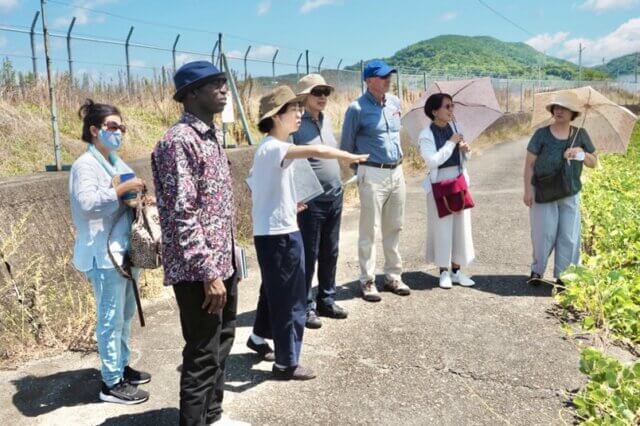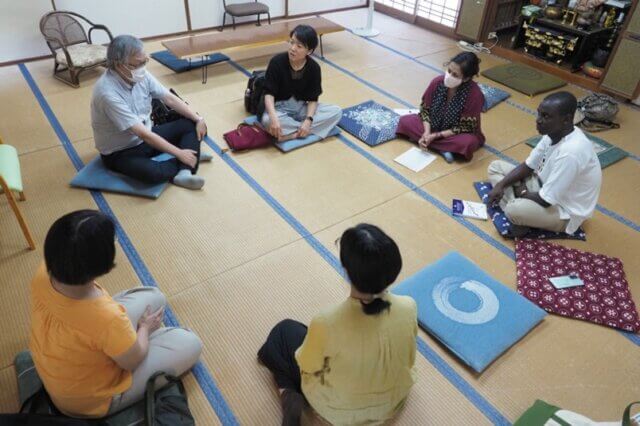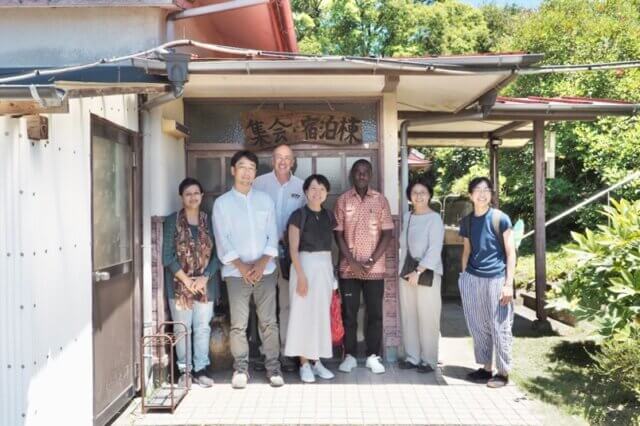In July, DrPH program participants embarked on a three-day excursion to Minamata. This trip was arranged in response to strong interest from students concerned about pollution’s significant environmental and health impacts. With assistance from the Minamata Disease Supporting Center Soshisha, the group visited Minamata City, where they engaged with local residents affected by Minamata disease, including patients and their advocates. The students also attended presentations by researchers and toured relevant sites and facilities in the area.
Please read the report essays by participating students Iffat Jahan (from Bangladesh) and Saheed Ibrahim (from Ghana).
Field Trip to Minamata: A Journey into Public Health Lessons from its Legacy
Iffat Jahan
The Minamata field trip was a three-day experiential learning opportunity organized by the DrPH faculty for the second cohort of DrPH students. Its primary objective was to gain a comprehensive understanding, from a public health perspective, of the causes of Minamata Disease and the factors that contributed to its ongoing impact—many of which remain unresolved to this day.
Throughout the trip, students examined how the lessons learned from Minamata can be applied to address contemporary and future public health challenges, particularly those related to environmental pollution.
This field trip was coordinated by the Minamata Disease Supporting Center Soshisha, which supports victims of Minamata Disease, offers consultations, promotes research on the incident, and disseminates findings to raise awareness and drive effective solutions.
Nature’s Resilience: Uncovering Minamata’s Scenic Beauty
Minamata City, situated in the southern tip of Kumamoto Prefecture, is a charming seaside town embraced by lush greenery and natural beauty. Despite its somber history, the town boasts serene landscapes featuring views of the Amakusa Islands across the Shiranui Sea. The town, cradled by a ria coastline and encircled by hills on three sides, benefits from nutrient-rich waters cascading from lush mountains. This once made it a prosperous fishing area, renowned as a place where fish seemed to spring forth. The Minamata and Ashikita region is renowned for its stunning coastal and mountain landscapes, hot springs, and an abundance of fresh seafood, fruits, and produce. The unique convergence of ocean, river, and terrain has historically provided natural resources that have sustained and enhanced the lives of its inhabitants.
From Tragedy to Recovery: The Transformation of Minamata Bay’s Eco Park:
The Kumamoto Prefectural Government launched the Environmental Restoration Project in Minamata Bay in 1977, to tackle mercury pollution resulting from industrial waste discharged by the Chisso Corporation. The initiative focused on extracting and isolating mercury-contaminated sediment, especially in highly polluted zones. This was accomplished through the use of synthetic sheets and soil to halt further contamination. The project, which was financed by Chisso, national government and the Kumamoto prefectural government, concluded in 1990 after 13 years and substantial monetary investment. Subsequently, the rehabilitated area was converted into Eco Park Minamata, serving as a symbol of environmental recovery and dedication to a healthier lifestyle.
This visit highlighted the importance of incorporating environmental sustainability into public health strategies from a planetary health standpoint. We gained a clearer understanding of environmental justice, observing how ecological deterioration significantly impacted underprivileged communities. This experience emphasized the importance of interdisciplinary approaches that blend health, environmental science, and social justice for future DrPH projects, especially in areas where industrial activities pose threats to both environmental and human well-being.
Stepping Back into History: The Shoshisha and Minamata Disease Museums:
The Shoshisha Minamata Disease Museum serves as a repository and exhibition space for artifacts and testimonies from those affected by and advocating for awareness of the disease. It features approximately 100 exhibit panels, images, and fishing equipment that demonstrate the community’s reliance on the fishing sector. A significant item on display is the cage used in Dr. Hosokawa’s 1959 research that established a connection between mercury pollution and Minamata Disease.
The Minamata Disease Municipal Museum provides an organized presentation of the disease’s inception, spread, consequences, legal obligation, and restoration initiatives. This museum also links Minamata Disease to broader global concerns through the Minamata Convention on Mercury, underscoring the importance of proactive public health policies.
From the perspective of a Doctor of Public Health (DrPH) focused on planetary health, both museums underscore the crucial role of public health advocacy and robust policy frameworks in tackling industrial pollution and environmental inequities. They highlight the necessity of proactive health governance and international cooperation to prevent similar public health and environmental crises in the future. This aligns with the planetary health agenda, which aims to protect both human health and the environment.
Advancing Research and Care: The National Institute for Minamata Disease (NIMD)
The National Institute for Minamata Disease (NIMD) was founded to promote research and enhance treatment for individuals affected by Minamata disease. Its scope was later broadened to encompass global efforts in addressing both social and scientific aspects of the condition, as well as disseminating findings worldwide. As a DrPH student, visiting the NIMD and listening to the talk of an expert scientist on the health hazards of mercury poisoning, particularly the risks to fetuses, infants, and ecosystems, was highly enlightening and impactful.
Lessons from Minamata diseases
Saheed Ibrahim
Throughout history, man has been exploring and discovering ways to improve living conditions and creating solutions to problems associated with daily lives. This led to the invention of several advanced equipment and services in medical, automobile, agricultural, and several other industries. This defines the so-called industrial revolution era. However, legitimate questions have been raised in recent decades regarding the effects of the industrial revolution. The phenomenon that was consider the game changer setting the pace for technological advancement has suddenly been regarded a debacle threatening the very existence and well-being of human folk. At the apex of the complex challenges posed industrialization is global warming.
After discussing the above and a series of related issues including environmental pollution, the Interfaculty Initiative in Planetary Health of Nagasaki University organized a three-day filed trip to Minamata city for the 2nd batch of Doctor of Public Health (DrPH) students. The main objective of the trip was to expose them to facts and causes of Minamata disease. This was to also contribute to their general understanding of the impact on environmental pollution on the need for mitigation of such phenomena.
After assessing the full scope of the pollution effect, it begs the question if it is worthy of sacrificing human life, health and well-being while mortgaging that future generations for industrialization and development. Unfortunately, such is the case of the people of Minamata city who are perpetually paying the expensive price of the establishment of a factory (CHISSO)in their city. Chisso Minamata factory was set up in 1908 apparently to lubricate the wheels of development and boast economic and social growth of Minamata city, Japan and to an extent other countries. Unfortunately, it eventually posed a problem that created an indelible pain and anguish in the mind and heart of the people. In 1932 Chisso became one of the first companies in Japan to that started producing Acetaldehyde, a material used in the manufacture of plastics and other chemicals.
Highly toxic methylmercury, created in the acetaldehyde manufacturing process flowed into the Minamata Bay through a drainage outlet in the Hyakken district of Minamata city. The continuous discharge of untreated chemical wastewater from Chisso Minamata plant resulted in large quantities of sedimentary sludge containing mercury accumulating on the seabed. This eventually polluted the Yatsuhiro Sea (Shiranui Sea). Abnormalities were confirmed in creatures around Minamata Bay. Even before residents presented symptoms of a serious condition that was unknown, cats and birds were the first to be affected the condition that was later termed Minamata disease. The first official case was reported on May 1, 1956, so devastating was the disease that no living creature that encountered it was spared. Birds were falling from the sky, dead fish floating on the sea and cats dancing. People, especially fishermen and their families were affected by eating contaminated fish. The effect ranged from neurological complications to death. Sensory disturbances due to the central nervous system, numbness of the limbs, tremors, narrowing of visual field, dysarthria, headache, dizziness and ataxia are some of the clinical manifestations of Minamata disease. Even generations unborn at the time to the incident were not left out as pregnant women passed on the condition to their babies that were still undergoing perinatal development. These babies were later born with the full blown disease referred to as Minamata Fetal disease.
Beyond the medical conditions that sucked the livelihood and relevance out of the patience was the effect of unabated stigmatization, social rejection and ridicule by a cross-section of the society. This did not only result in emotional trauma to patients and their relatives, it also discouraged them from disclosing their condition and deprived them of the care and support they deserved. Patients lost their jobs and stood no chance getting married.
The dominance and influence on government significantly contributed to the escalation of the cases as call by residents of Minamata and early researchers to halt the operation of Chisso Minamata factory. The opportunity to abate the date was lost because the government was seemingly in bed with it’s chief financier.
Even after some individuals and social groupings mobilized the patients are initiated a compensation mechanism to at least cater for the medical and social needs of the patients and their dependents, there is still a legal battle that continue to disqualify or deny some patients of these compensatory support from Chisso and government.




